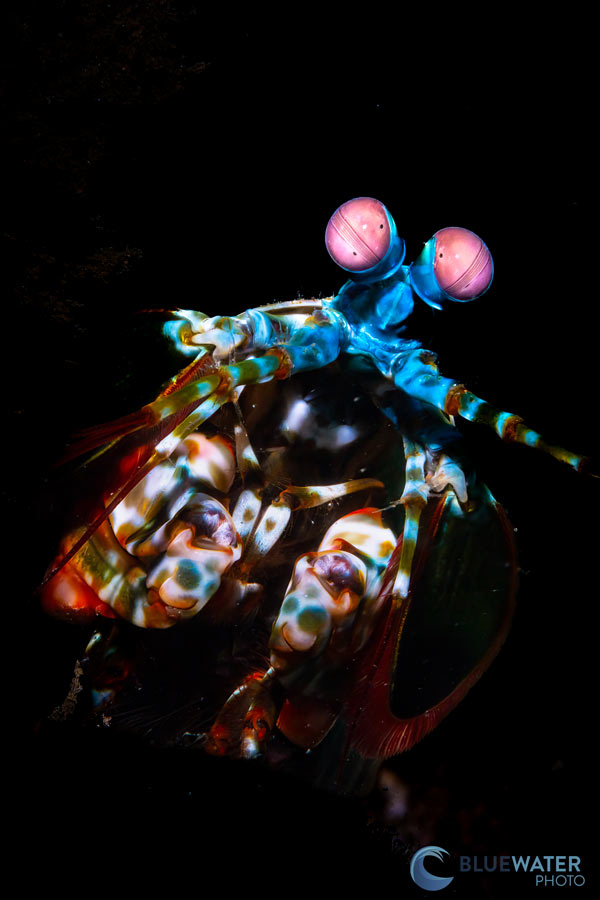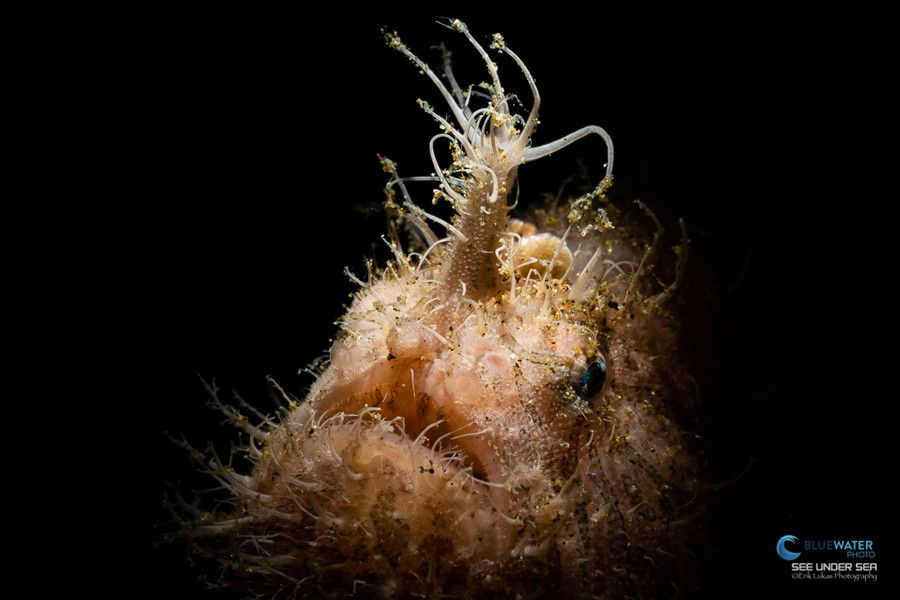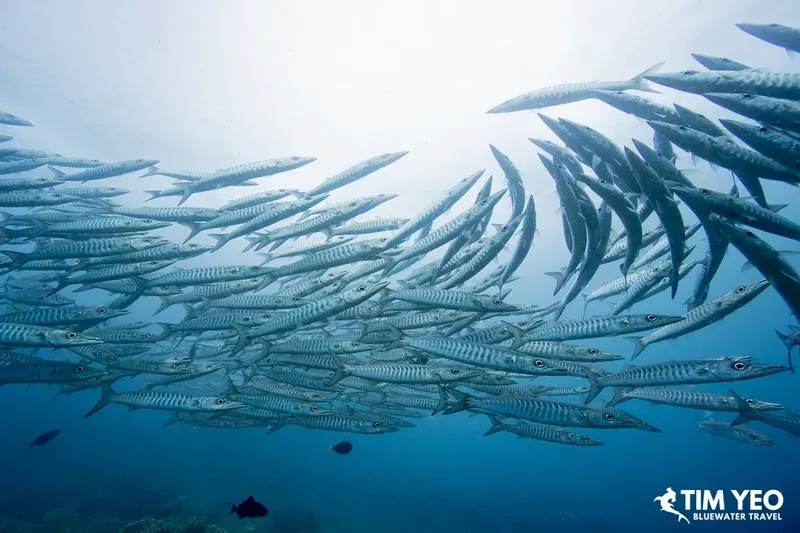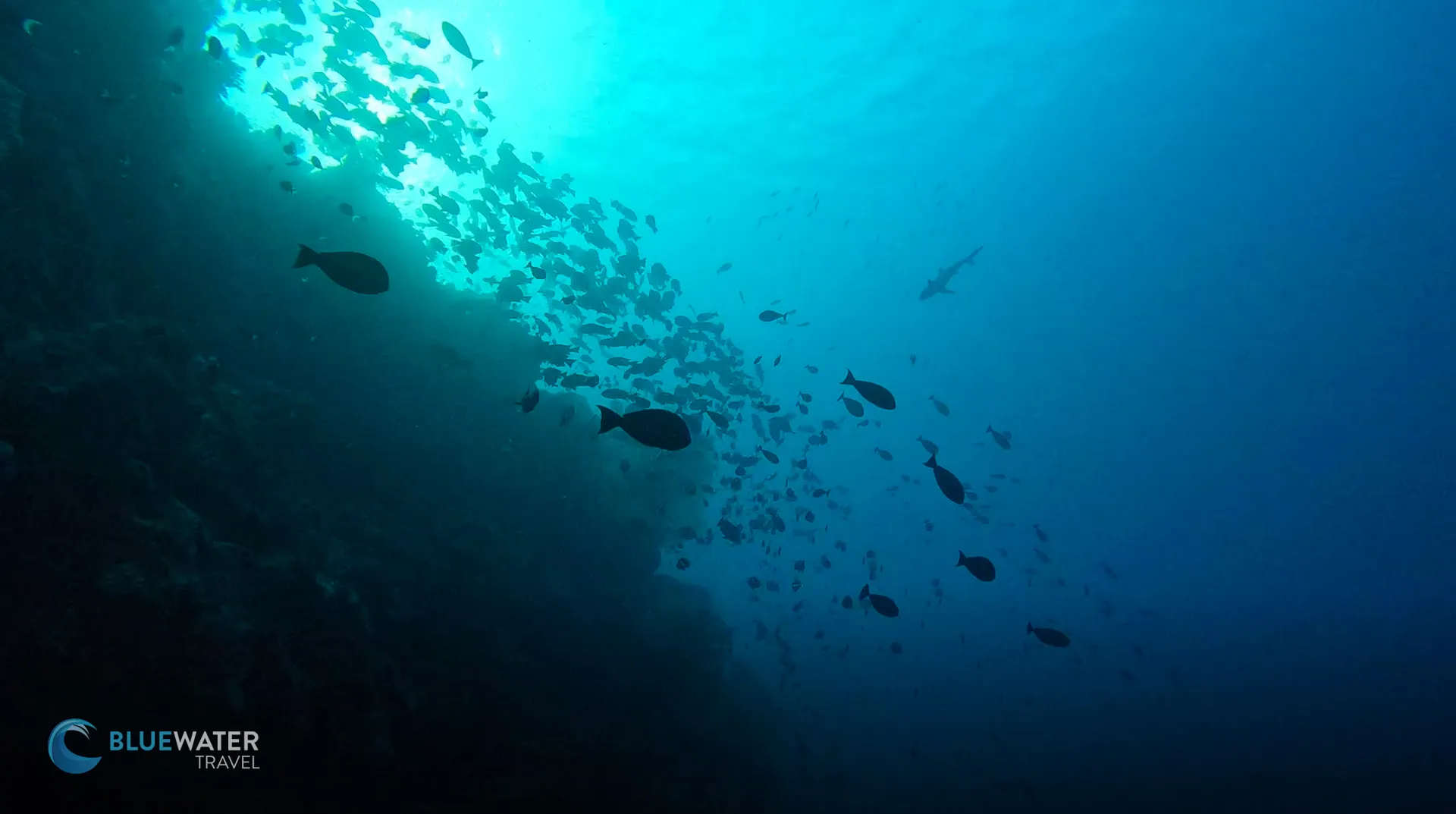Best Diving in Southeast Asia - Top 10
Explore the best diving throughout Southeast Asia, including top areas in Indonesia, Malaysia, Thailand, and the Philippines. Discover where to stay, how to get there, and diving information.

Best Diving in Southeast Asia - Top 10
With the Indo-Pacific Coral Triangle at its heart, Southeast Asia is home to some of the world's best scuba diving. Boasting pristine coral reefs, a huge diversity of marine species, exceptional macro, swimming with whales, sharks, and exciting wrecks there's something for everyone in Southeast Asia!
On top of all that, the diving is suitable for all levels and can be enjoyed from an assortment of amazing dive resorts and liveaboards. The warm waters and picturesque landscapes will give you some of the best memories in your entire scuba diving life.
With so many destinations and amazing dive spots, deciding on the best place to dive in Southeast Asia is no easy task. But worry not! We've rounded up a list of the best scuba diving destinations in Southeast Asia, complete with information on what to see, when to go, and where to stay, so that you can pick the perfect spot for your next dive vacation, hassle-free!
Southeast Asia's Best Diving Spots
Pick a destination or scroll down to read the entire list:
1. Tubbataha Reefs Natural Park, the Philippines - Highest Biodiversity in the Philippines
2. Raja Ampat, West Papua, Indonesia - Richest Marine Life in Southeast Asia
3. Anilao, Batangas, the Philippines - Best Muck Diving in the Philippines
4. Lembeh, North Sulawesi, Indonesia- Muck Diving Capital of Southeast Asia
5. Similan Islands, Thailand- Gem of the Andaman Sea
6. Dauin, Dumaguete, the Philippines- Best All-In-One Luxury Dive Vacation Spot in Southeast Asia
7. Derawan Islands, Borneo, Indonesia- Southeast Asia's Best Kept Secret
8. Sipadan, Borneo, Malaysia - Exclusive Access to Exceptional Marine Life
9. Coron Bay, Palawan, the Philippines- Best Wreck Diving in Southeast Asia
10. More Awesome Places to Dive inSoutheast Asia
BONUS #1: Best Time to Dive
BONUS #2: Flight Information
Can't wait to start planning your trip to Southeast Asia? View the live availability of some of the best liveaboards in the Philippines, best liveaboards in Indonesia, or check out our area guides for choosing the best dive resorts in the Philippines and the best dive resorts in Indonesia!
1. Tubbataha Reefs, Palawan, Philippines
Located in Palawan, at the heart of the Sulu Sea, Tubbataha Reefs Natural Park is arguably one of the best diving spots in Southeast Asia. This UNESCO World Heritage Site boasts incredible biodiversity, making it one of the Philippines' best dive locations.
Highest Biodiversity In The Philippines
The gorgeous Tubbataha Reefs National Park
The reefs of Tubbataha are home to at least 600 species of fish, 360 species of corals, 11 species of sharks (including tiger sharks, whale sharks, and whitetip reef sharks), 13 species of marine mammal, and hawksbill and green sea turtles. Divers will also spot manta rays alongside large schools of barracuda and tuna, as well as numerous critters and macro life.
The Tubbataha dive season runs from February until June when sea conditions are at their calmest.
Learn more on Tubbataha diving.
Where To Stay
Tubbataha can only be accessed via a liveaboard. A week-long liveaboard trip is the norm but you can find longer transition itineraries in combination with other areas in the Philippines.
View all liveaboards in Tubbataha.
How To Get To Tubbataha
Fly into Manila's Ninoy Aquino International Airport(MNL) and take the hour long domestic flight to Puerto Princesa International Airport (PPR). The majority of Tubbataha liveaboards depart from Puerto Princessa and the transit takes around 10 hours.
See how to get to the Philippines.
Diving Conditions
Water Temperature: 80 to 86oF (26 to 30oC).
Visibility: 32 to 114 feet (10 to 35m) depending on the tides.
Non-Diving Activities: Tubbataha is suitable for snorkelers.
Required Skill Level: Intermediate to Advanced recommended. Strong currents might be present at some of the sites.
2. Raja Ampat, West Papua, Indonesia
No guide to diving Southeast Asia would be complete without mentioning the home world's richest coral reefs, Raja Ampat. The region's reefs are home to over 1,400 fish species and 72% of the world's known coral species, making it the most species diverse marine environment on the planet.
Richest Marine Life In Southeast Asia

Yellow gorgonian captured by Mark Strickland while leading one of our Raja Ampat trips.
Raja Ampat covers a huge area, and some of the best diving can be found in the Dampier Strait, where Cape Kri holds the world record for the most species rich dive site. The long list of marine life that can be seen on a Raja Ampat dive trip includes endemic species such as the Raja Ampat epaulette shark, tasseled wobbegong shark, and Papuan garden eel as well as reef sharks, manta rays, and countless reef fish.
The Raja Ampat dive season runs from October to May when the seas are at their calmest.
Where To Stay
Raja Ampat can be explored from a resort or by liveaboard, and which you choose will depend on the type of trip you are looking for.
Raja Ampat is home to numerous dive resorts, from mid-range to luxury. Staying at a dive resort could be a great addition before or after a liveaboard trip in Raja Ampat.
Raja Ampat has many great liveaboard options, from basic and mid-range liveaboard boats to some of the luxurious boats in the world. The liveaboard operations in the area are renowned for their service and hospitality.
View all liveaboards and dive resorts in Raja Ampat or learn more on diving Raja Ampat.
How To Get To Raja Ampat
Getting to Raja Ampat can be quite difficult. The recommended route is to fly internationally into Jakarta's Soekarno-Hatta International Airport (CGK), stay overnight, and then catch the 4-hour direct flight to Sorong' Domine Eduard Osok Airport (SOQ), the departure point for most liveaboards.
Diving Conditions
Water Temperature: 80 to 86oF (26 to 30oC) year-round.
Visibility: Avg. 30 to 70 feet (8 to 20m).
Non-diving activities: Hiking, nature, and cultural tours.
Required Diving Skill Level: Intermediate to Advanced recommended. Strong currents may require use of a reef hook or negative entry.
3. Anilao, Batangas, Philippines
Anilao is one of the best macro photography destinations in Southeast Asia, and it is only a 2-hour journey from Manila in the Philippines.Photographers can discover a huge range of tiny subjects within meters of the shore, and the muck diving and black water diving here are hard to beat.
Best Muck Diving In The Philippines
Hairy frogfish is one of the many species of frogfish that you'll find while diving in Anilao, especially at Secret Bay!
Anilao is home to a massive range of critters and macro species, including nudibranchs, frogfish, seahorses, cuttlefish, and pipefish to name a few In addition to this, beautiful coral reefs are home to turtles, huge schools of jacks, jellyfish, and the occasional reef shark.
Prepare your critter list with this comprehensive guide on muck diving.
The diving season in Anilao is year-round.
Learn more on Anilao diving and read about our last trip there from our Anilao Dive Report.
Where To Stay
Diving in Anilao is predominantly land-based. and there are plenty of great dive resorts to choose from.
Here at Bluewater Photo & Travel, we have been running macro photography workshops at Crystal Blue Resort in Anilao for the past 10 years. Located in Bagalangit, the heart of Anilao, the resort has everything an avid diver and underwater photographer needs; comfortable rooms, easy access to the dive sites, knowledgeable dive guides, and top-notch photography amenities.
Interested in macro photography?Join ourphoto workshops at Crystal Blue Resort in December 2024 or April/May 2025.Daily workshops provided at no extra cost!
How to Get to Anilao
Anilao is one of the easiest Southeast Asia scuba diving destinations to get to. Fly into Manila's Ninoy Aquino International Airport (MNL), and Anilao is only a 2-3 hour ride along the coast. Most resorts offer return transfers, sometimes for free, so getting there and back is really a breeze.
See how to get to the Philippines.
Diving Conditions
Water Temperature: 77 to 81oF (25 to 27oC).
Visibility: Avg. 40 to 50 feet (10 to 15m).
Non-diving activities: Snorkeling and kayaking.
Required Diving Skill Level: Anilao is beginner-friendly since most of the sites are not deep and strong currents are rarely present.
4. Lembeh, North Sulawesi, Indonesia
The Lembeh Strait in North Sulawesi is known as now as Southeast Asia's capital for muck diving, and itsexceptional macro marine diversity makes it arguably the best spot in the world for discovering macro species. This reputation has helped develop Lembeh's fantastic dive infrastructure, with most resorts catering to photographers and offering first-rate guides and spotters.
Muck Diving Capital Of Southeast Asia

Hairy frogfish yawning. Shot by Matt Sullivan while leading a Bluewater macro photography workshop in Lembeh.
On a typical Lembeh dive trip, you can seehairy frogfish, flamboyant cuttlefish, juvenile barramundi, cods, juvenile pinnate batfish, rhinopias, harlequin shrimps, mandarin fish, snakeblennies in the open, large beautiful stinging anemones; it's almost impossible to list them down on one page.
Check out the ultimate critter list with over 130 macro species found across Anilao, Bali, and Lembeh on our sister website uwphotographyguide.com.
Learn more on diving Lembeh.
Where To Stay
Scuba diving in Lembeh is usually done via a dive resort and there are a lot of excellent dive resorts in Lembeh Strait with a wide range of pricing.
View all dive resorts in Lembeh.
How To Get To Lembeh
Most people fly to Manado's Sam Ratulangi (MDN) through Singapore Changi Airport (SIN) on a 3.5-hour flight. You can also get a direct flight fromJakarta's Soekarno-Hatta International Airport (CGK)or Bali Ngurah Rai International Airport (DPS). Resorts will usually pick you up at Manado airport.
Diving Conditions
Water Temperature: 77 to 82oF (25 to 28oC) - July and August are the coldest months.
Visibility: 30 feet (8m) year-round.
Non-diving activities: Wildlife excursions and relaxing.
Required Diving Skill Level: Lembeh is beginner-friendly since most of the sites are not deep and strong currents are rarely present.
5. Similan Islands, Thailand
Thirty miles off the coast of southern Thailand, the eleven islands of the Mu Ko Similan National Park offer access to the Andaman Sea's best diving spots. The beauty and accessibility of these islands were very nearly their downfall, and the area was closed to tourists for several years to reduce the impact of too many visitors.
The Gem of the Andaman Sea
Most of Southeast Asias extensive marine catalog can be found in the waters around the Similan Islands. Between December and April, whale sharks and manta rays can be spotted, while blacktip and whitetip reef sharks, zebra sharks, and leopard sharks are year-round residents. Add to this various types of ray, barracuda, giant trevally, four species of turtle, and an abundance of reef fish and critter life for some exceptional diving.
Where To Stay
There is a wide range of liveaboard options, from modern motor yachts to a traditional junk. Liveaboards generally visit for 4-nights or 7-nights, and some combine a longer trip with a visit to the nearby Surin Islands and Richelieu Rock. Boats tend to depart from Khao Lak on the mainland, but there are also departures from Ranong and Phuket.
How To Get To The Similan Islands
Several airlines fly from the US to Thailands Phuket International Airport (HKT) with a layover in Europe or Asia. Once in Phuket, its a 90-minute drive to Khao Lak to pick up the liveaboard.
Diving Conditions
Water Temperature: 83 to 87oF (28 to 30oC) year-round).
Visibility: Excellent, up to 150 feet (45m).
Non-diving activities: Wildlife excursions and relaxing.
Required Diving Skill Level: Most liveaboards will offer at least one land excursion to visit the islands tropical interiors.
6. Dauin & Dumaguete, Philippines
Only 20 minutes from Dumaguete city on the island of Negros, Dauin is a world-class diving destination for macro photography. The Dumaguete area is best known for its excellent muck diving, great coral reefs nearby, and its assortment of luxurious beachfront dive resorts, which are relatively affordable compared to other diving destinations in Southeast Asia.
Best All-in-One Luxury Dive Vacation Spot In Southeast Asia
Left: A massive school of jacks, seen at Apo Island on a Bluewater trip in June 2019. Right: Whale shark snorkeling at Oslob.
A huge range of macro species can be discovered at Dauin, including various types of frogfish, dragonets, pipefish, nudibranchs, blue-ring octopus, bobtail squids, mandarin fish, seahorses, cardinalfish, various shrimps, and crabs.
The main diving season in Dumaguete is October to early June, but the prolific marine life of Dauin can be found all year round, so theres no worry of missing out.
Learn more on Dumaguete diving and read about our latest trip from Dumaguete Dive Trip Report. Join our Dumaguete Group Trip in June 2025.
Where to Stay
Some of Southeast Asia's best luxury resorts can be found in the Dumaguete area. Most cater to underwater photographers, and all have great dive facilities.
How to Get to Dauin & Dumaguete
From Manila's Ninoy Aquino International Airport(MNL), take a 45-minute internal flight to Dumaguete - Sibulan Airport (DGT). Most resorts offer return transfers free of charge.
See how to get to the Philippines.
Diving Conditions
Water Temperture: 77 to 81oF (25 to 27oC).
Visibility: 30 to 40 feet (8 to 12 m) in Dauin, 60 to 90 feet (15 to 25m) in Apo Island.
Non-Diving Activities: Snorkel with whale sharks at Oslob, soak up the sun, eat and drink very well at the luxury resort of your choice, and try out all the different spa treatments available at your resort.
Required Diving Skill Level: Dauins dive sites are relatively easy to dive for all divers, experienced or not.
7. Derawan Islands, Borneo, Indonesia
Off the east coast of Indonesian Borneo, the Derawan archipelago offers vibrant marine life and a huge variety of coral reef dives, caves, walls, lagoons, and even a jellyfish lake. Such diversity is only truly appreciated after exploring and diving these spectacular islands.
Southeast Asia's Best Kept Secret
Expect to spot a wide range of marine species, from giant turtles, dolphins, manta rays, whales, and dugongs to tiny pygmy seahorses and nudibranchs. With over 870 species of fish and 460 types of coral, there is something to discover on every dive.
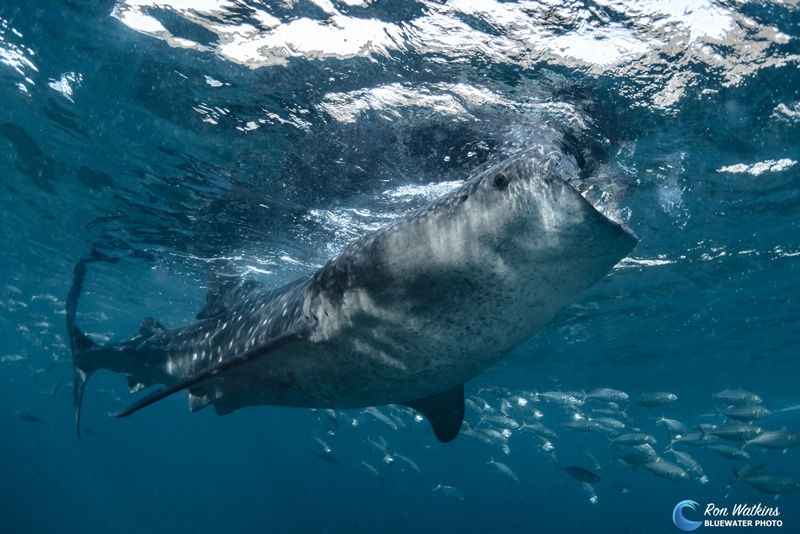
Whale shark that is filter feeding at the surface.
The rainy season begins around November to April and the dry season lasts May to October.
Learn more about diving the Derawan Islands.
Where To Stay
There are dive resorts & dive operators available in Derawan Islands, as well as liveaboards operating in the area.
View all liveaboards in Indonesia.
How To Get To The Derawan Islands
To reach Derawan, you need to fly intoSultan Aji Muhammad Sulaiman Sepinggan International Airport (BPN) near Balikpapan on mainland Borneo.Direct flights are available from Singapore, Jakarta, Surabaya, or Denpasar. Once in Balikpapan, take a connecting flight to Raja Alam International Airport (BEJ) in Tanjung Redeb, Berau. From here, boats will take you out to the islands.
See how to get to Borneo.
Diving Conditions
Water Temperature: 82oF (28oC) year-round.
Visibility:Averages 65 feet (20m).
Non-diving Activities:Swimming and snorkeling on the beautiful beaches, island-hopping tours.
Required Diving Skill Level:Suitable for all levels.
8. Sipadan, Borneo, Malaysia
A renowned dive destination just off the coast of Malaysian Borneo, the island of Sipadan has been rated as a world-class dive destination since Jacques Cousteau visited in the early 80s. Access has been limited since 2004, and the only way to visit is via day boat from neighboring island resorts. Diving is only possible at Sipadan Island Park with a permit, so planning ahead is essential to make sure you don't miss out.
Exclusive Access To Exceptional Marine Life
This is one of the big fish capitals of the world, and every dive site is loaded with flashy schools of anthias, jacks, triggerfish, and barracuda. All along the reef, angelfish, anemone fish, nudibranchs, lionfish, eels, octopus, and many more species can be found lurking between coral heads.
The diving season in Sipadan is year-round, with April to December offering the calmest surface conditions.
Find out more about diving Sipadan.
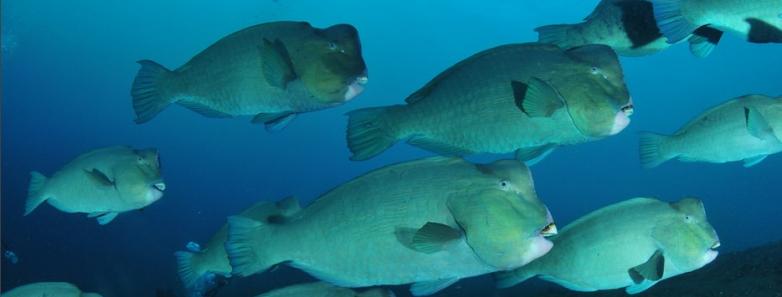
A group of bumphead parrotfish.
Where To Stay
There are numerous dive operators and resorts in the Sipadan area, many offering all-inclusive packages. The boat journey from islands such as Mabul and Kapalai normally takes 20 to 30 minutes.
How To Get To Sipadan
Getting to Sipadans neighboring islands can be quite a task. The main gateway is Kota Kinabalu International Airport (BKI), from where a domestic flight takes you to Tawau Airport (TWU) on the southern tip of Malaysian Borneo. From Tawau, resort transport will transfer you the 90-minute journey to the port town of Semporna, where youll board a boat out to your resort.
Diving Conditions
Water Temperature: 79 to 86oF (26 to 30oC).
Visibility: 60 to 100 feet (15 to 30m).
Non-diving Activities: Many of the resorts offer kayaking and beach sports, spa facilities, and plenty of long sandy beaches to relax on.
Required Diving Skill Level: Suitable for all levels, although strong currents may be present at some sites.
9. Coron Bay, Palawan, Philippines
Home to the best wreck diving spots in Southeast Asia, as well as stunning limestone cliffs and tranquil lagoons, Coron is a popular resort town on the south of Basuanga Island.
Best Wreck Diving In Southeast Asia
Coron Bay was used as a harbor by the Japanese fleet during WWII, and 11 ships met their watery end here during an air raid in September 1944. These wrecks are now flourishing reef systems, home to an exciting array of marine life. Some of the residents of these wrecks include scorpionfish, nudibranchs, cuttlefish, and octopuses. Youll even see the occasional reef shark or stingray hovering near the wrecks.
Find out more about the world's best wreck spots.
Diving the wrecks of Coron
While diving is available in Coron year-round, October to June is considered the optimum time to dive.
Learn more about scuba diving Coron.
Where To Stay
Coron can be explored from one of many resorts that offer diving around Coron Island and nearby Apo Reef. It is also a popular stopping-off point on the itinerary of numerous liveaboards that explore the Palawan region.
View all liveaboards in the Philippines.
How to Get to Coron
After flying to Manila's Ninoy Aquino International Airport(MNL), you have two options to get to Coron. Either take the 1-hour internal flight to Francisco B. Reyes Airport (USU) in Busuanga, followed by a 45-minute road transit to Coron. Or take the 13-14 hour ferry crossing from Manila to Coron.
See how to get to the Philippines
Diving Conditions
Water Temperature: 79 to 88oF (24 to 31oC) with the water in the summer months being warmer.
Visibility: Can reach up to 80 feet (24m) in certain areas.
Non-diving Activities: Island-hopping, beach hunting, snorkeling, and kayaking. A lively nightlife scene is present if you opt for a land-based accommodation/resort.
Required Diving Skill Level: Beginner to Advanced. Most of the wrecks of Coron are not too deep and can be enjoyed by divers of all levels.
10. More Awesome Places to Dive in Southeast Asia
Bali in Indonesia has long been popular with tourists and divers, and for good reason. Manta rays and mola mola are regularly encountered around the island of Nusa Penida, and the Liberty wreck is a fantastic dive on the islands' east coast near Tulamben.
Also in Indonesia, the island of Komodo might be best known for its land-based 'dragons', but marine life on the southern side of the island is also big, bold, and beautiful. Powerful currents sweep nutrient-rich waters over the island's stunning reefs, making for some fantastic drift diving.
Puerto Galera is a popular resort area on Mindoro Island in the Philippines. It offers colorful diving on vibrant reefs, and a good range of macro and wide-angle photo opportunities.
The island of Malapascua is on many Philippines liveaboard itineraries, mainly due to the thresher sharks that visit shallow reefs near the island every morning.
Is there any other place that should be on this list? Let us know your thoughts!
Best Time To Dive In Southeast Asia
Philippines
The dive season in the Philippines runs year-round, however some areas (such as Tubbataha) are only accessible at certain times. November through to May is the dry season and generally the best time to dive, however it is also the busiest.
Thewater temperaturesthroughout the country hover at79 to 88oF (24 to 30oC) year-round and a 3-5mm full wetsuit will suffice. Temperatures are coldest at the beginning of the year, from January to March, and are warmest in the middle of the year.
Indonesia
Most of Indonesia can be dived year-round, with March to October being the most popular time. Generally speaking,May to Septemberis the dry season andOctober to April isthe rainy season, however, in certain dive areas like Raja Ampat this is reversed. In this case, November to April is the best time to visit.
The water temperatures remain around82 to 85oF(26 to 29oC) year-round. Typically, you won't need anything more than a 3-5mm wetsuit, or even a skinsuit.However, some areas, such as parts of Bali and the south of Komodo, experience colder waters.
How To Get To Southeast Asia
Philippines
Ninoy Aquino International Airport(MNL) in Manila and Mactan-Cebu International Airport (CEB) are the two main gateways for international visitors to the Philippines.
Indonesia
Soekarno-Hatta International Airport (CGK) in Jakarta, Ngurah Rai International Airport (DPS) in Bali, and Sam Ratulangi International Airport (MDC) in Manado are the three main international hubs serving Indonesia.
Borneo
The main gateway into Malaysian Borneo is through Kota Kinabalu International Airport (BKI). There are numerous cheap flights daily from the Malaysian capitals Kuala Lumpur International Airport (KUL) to Kota Kinabalu.
The primary airport in Indonesian Borneo is Sultan Aji Muhammad Sulaiman Sepinggan International Airport (BPN) near Balikpapan. There are direct flights from Kuala Lumpur and Singapore.
Plan Your Southeast Asia Dive Vacation
Bluewater Travel is a full-service dive travel agency. We can book you a resort or a liveaboard virtually almost anywhere in Southeast Asia (and the world) at the same price, or even lower, than booking any other way. Our team of travel advisors has been to most of these places, some of them even many times. We know the diving, resorts, liveaboards, and logistics better than anyone else in this industry. To get started, you can:
Email us or leave us a message through the live chat box to start planning your trip!
Find out why Atlantis Dive Resorts & Liveaboards is our Preferred Partner in the Philippines.
Further Reading
Check out these useful resources from our sister websites, Bluewater Photo and Underwater Photography Guide
Southeast Asia's Best Underwater Photography Destinations
Top 10 Macro Photography Destinations
Wet Wide Angle Lens Buyer's Guide

